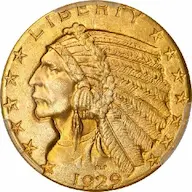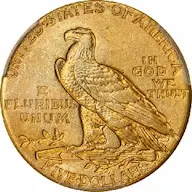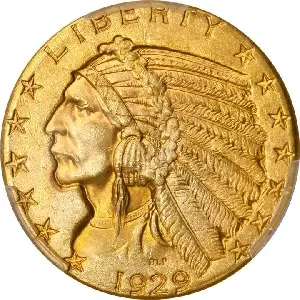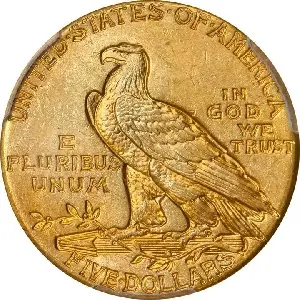1929 Indian Head $5 Half Eagle
The Indian Head theme was introduced in 1908 on the United States $2.50 quarter eagle and $5 half eagle. Designer Bela Lyon Pratt broke new ground in American coinage by indenting features into the coin, rather raising them above the surface in the traditional manner. Numismatists often refer to Pratt’s work as an “incused” design.(1)
The foremost agent of change during the early years of the 20th century was President Theodore Roosevelt. One of his goals was to upgrade the artistic qualities of U.S. coinage, to the level of becoming a source of national pride on the world stage.
Pratt depicted a resolute Native American in full bonnet on the obverse. The main device on the flip side is a stately eagle perched upon a fasces bundle, as if a sentinel on patrol. An olive branch represents peace, complimented by an arrowhead suggestive of military strength.
The Indian Head was minted every year from 1908 until 1916, inclusive. The coining presses were fired up again in 1929, when the Philadelphia Mint produced 662,000 Indian Head eagles, but these were not released immediately.(2)
Following the stock market crash of October 1929, extensive business and bank failures caused massive unemployment. As the Great Depression settled in, the need for more $5 half eagles diminished accordingly, so few 1929 half eagles exited Treasury control.
After President Franklin Roosevelt’s Gold Recall Order of 1933, the remaining government supply of 1929 half eagles were melted, cast into ingots, and deposited in Fort Knox.(3) Less than one thousand escaped this fate. Survivors today exist mostly in mint state condition, in grades MS-64 and lower.(4)
The Indian Head half eagle series is relatively short, beautiful, and imminently collectible. There are only two “roadblock” dates in completing a set: The 1909-O and the 1929. Both these rare coins have been subjected to intense collector demand since at least the 1960’s (Rare Coins 101 research goes back to 1950).
If past is prologue (as it usually is with coin collecting rarities), going forward no one should bet against the 1929 Indian Head half eagle.
| Estimated survivors in all grades: 783 ?
The survivor estimate from PCGS represents an average of one or more experts' opinions as to how many examples survive of a particular coin in all grades. Survival estimates include coins that are raw, certified by PCGS, and certified by other grading services. Learn more at PCGS. |
| PCGS Rarity Scale: 5.4 ?
The 'PCGS CoinFacts Rarity Scale' assesses the relative rarity of all U.S. coins, based on estimated surviving examples. The scale runs from 1.0 to 10.0. The higher the number, the rarer the coin.
Learn more at PCGS. |
| Search for the 1929 Indian Head $5 Half Eagle on eBay** |
Preview of eBay selection:
 |
 |
| Trendline Avg = 14.16 | GOOD |
 |
 |
| Trendline Avg = 14.16 | GOOD |
Historic Value Trend Charts:
| Last updated 8-11-25 | Return to Key Date Coin List | |
| Compare to Common Date Coin of Same Type | ||
|
|
||
| Download Charts to Your Computer | ||
Sources
1. Taxay, Don. The U.S. Mint and Coinage. New York, NY: Sanford J. Durst Numismatic Publications, 1966.
2. Heritage Auctions. 1929 $5 MS65. Sep 2020 Auction.
3. Stack's Bowers Galleries. 1929 Indian Half Eagle. Nov 2012 Auction.
4. PCGS. 1929 $5 (Regular Strike).
**Many very fine coin dealers sell on eBay. At any point in time, there may be over one million search results for United States coins. This includes quite a few of the recommendations on our Key Date Coin List.
If you’re thinking about purchasing a rare coin, eBay is certainly worth a look. For your convenience, the links from this site to eBay are coded to bring up only coins certified by PCGS and NGC.
As is always, always the case, never buy a valuable coin from a seller whose trustworthiness cannot be verified. Learn more about this at our chapter Best Places to Buy Coins, which also has a section on doing business on eBay.
In the interest of full disclosure, Rare Coins 101 receives a small commission anytime someone connects to eBay from this site and purchases something.
Coin images by Stack's Bowers Galleries.


